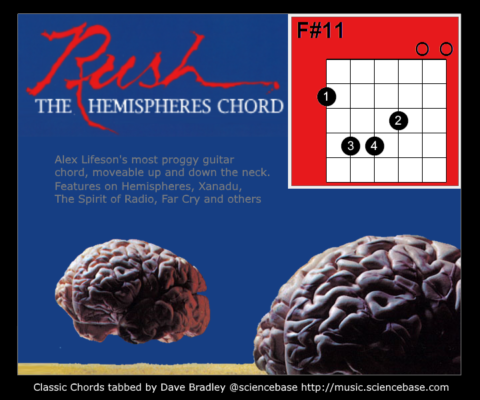TL:DR – The Hemispheres Chord, the Alex Lifeson chord. Used in lots of Rush songs is basically a barre F# major, but you lift your barre finger off the high E and B strings, makes it an F#11.
One thing I noticed as a teen teaching myself to pick out the wondrous chords played by Rush’s Alex Lifeson by ear was that he used a lot of chords where the top two strings, the B and the E string were left to ring while a moveable chord shape, often a B major shape or more commonly an F major shape (but, not barre) was relocated up and down the neck. Occasionally, the first finger would be on the B string to make a more conventional Fmaj shape but still with that E string ringing, and the whole chord often arpeggiated intricately rather than strummed as a unit.
However, it is the Fmaj shape shifted up a fret (a semitone) to give us the rather weird, dissonant, and suspended F#11 chord (F#,C#,F#,A#,B,E) [you could call it an F#7(add11)]. It powers the opening of the Hemispheres album and was later revisited as the big power chord of “Far Cry” from the 2007 Snakes & Arrows album.
Apparently, it was producer Nick Raskulinecz who had wanted the band to put a modern twist on some of their classic musical motifs and the Lifeson Chord stood out for him. Interestingly, the way Lifeson plays the first position Emaj in the intro with his pinkie adding a B on the third string and there being no G# resembles the modified chords he uses on Moving Pictures track “Limelight”.
The “Hemispheres Chord” itself features a lot throughout Rush’s early albums in various positions up and down the neck, on The Fountain of Lamneth, in Xanadu, Hemispheres (obvs), later on The Spirit of Radio and Natural Science. Other players have used similar chords to thicken their sound and to give the six-string something of a 12-string sound. If I remember rightly, it features on some Manic Street Preachers songs too and given that bassist Nicky Wire is a massive Rush fan, that’s perhaps no surprise. And, speaking of the Manics, they also use one of those Bmaj shaped chords on the song Design for Life more on that later in my Classic Chords series. Meanwhile, check out some of my own music influenced to no small degree by Rush, the Manics, and dozens of others over the years.
The Classic Guitar Chords archive will grow from here.
I should add that there is some controversy about this chord. When you’re learning guitar, it’s a fairly obvious thing to do, lift your barre index finger from an F major and move it around the fretboard, Dream Theater’s John Petrucci reckons Lifeson invented it. Alex certainly did it on Caress of Steel (Fountain of Lamneth) with a B and an A type chord at 7th, 5th fret, respectively. But, have a listen to Journey’s mid-1970s instrumental Nickel and Dime; recorded May – October 1976. Remind you of anything?
Fundamentally, one of the two bands was perhaps massively inspired by the other’s motif. Journey supported Rush on the 2112 tour for one gig, at least. Could Alex Lifeson or Neal Schon have been more than a little inspired by the other, did they jam together and share some ideas backstage? Rush have been great assimilators of musical styles throughout their careers. The Nickel and Dime riffing in the middle is almost identical to the Xanadu rocking between E and the F#11 and arpeggiating the top edge of the chord too…and actually again in Hemispheres, Natural Science and then the ending of Tom Sawyer. Xanadu was previewed live in May 1977 by Rush.
They were probably both written at about the same time, by two guitarists who heard each other play live on the same stages. As I understand it, Schon has some beef with Lifeson with regards to the popular Tom Sawyer and not any of the earlier songs where Lifeson used this motif that pre-date Journey’s output. Bizarrely, Journey’s big hit Don’t Stop Believing is to my ear almost a straight clone of The Spirit of Radio, so who is fooling whom?
Probably also worth pointing out that Jimmy Page uses this kind of chord coupled with an Em7 chord in Achilles’ Last Stand from the 1976 Led Zeppelin album Presence, which was recorded late in 1975 some time after Rush released Caress of Steel, but, of course, Lifeson is a big fan of Page. Be interesting to know whether he thinks he invented this chord. There will be many others long before the 1970s prog rock scene that used it!
